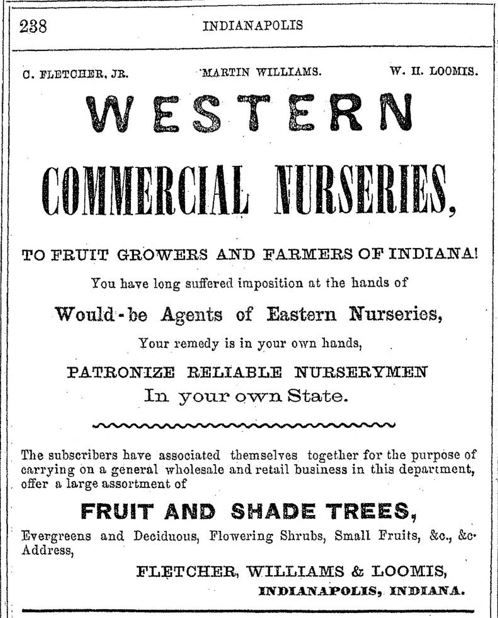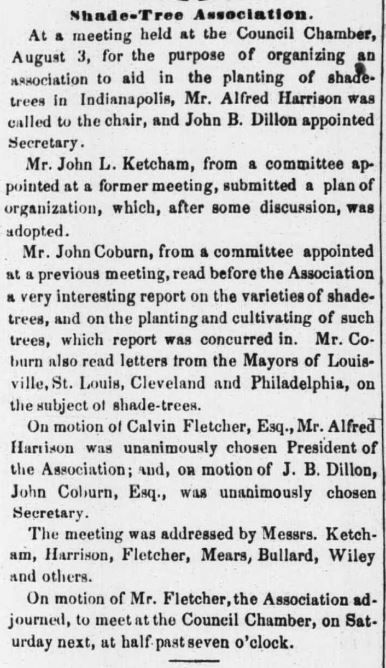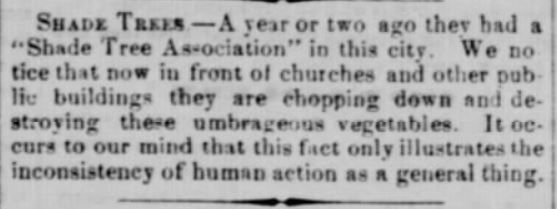The 1858 Shade Tree Association of Indianapolis
- Ed Fujawa
- Sep 29, 2019
- 8 min read
Updated: Apr 4, 2020
The land which is now Indianapolis and Marion County was once covered in a massive, mostly unbroken forest. Aside from the random clearings, and areas of prairie in northwestern and west central Indiana, most of the state was woodland. Western migration of European immigrants changed this, and the rapid settlement of Indiana was coupled with the steady destruction of much of Indiana’s tree canopy.
Marion County, and Indianapolis, was no exception with the vast majority of the city being cleared of forest at one time or another. However, in more modern times, efforts have been made to ‘green’ the city and encourage the planting of new trees.
An example of such a program can be seen when entering the county, usually in conjunction with a ‘Welcome to Indianapolis” sign: Tree City USA. The Tree City USA program began in 1976 and is run through the National Arbor Day Foundation. The designation is awarded to cities which satisfied various requirements, including having a tree care ordinance, a tree board or department, a community forestry program, and Arbor Day recognition. Indianapolis has been a Tree City since 1988. The 'Welcome to Indianapolis' signs one sees when entering Marion County used to have a separate sign noting this designation. However, the ones I have checked lately seem to be missing those.

In spring of 1990, the city launched the "Trees for Tomorrow" program (President H.W. Bush launched a nationwide program, by the same name), with an ambitious sounding goal of planting 30,000 in one year. The first tree was planted on April 4, 1990, when President Bush visited Indianapolis to plant an American elm tree which was a descendent of a tree planted at the White House in the 1820's, during the presidency of John Quincy Adams (the stop was also kind of a campaign event for then Mayor Hudnut who was running for secretary of state of at the time). The tree was planted in what turned into Presidential Place Park, a pocket park adjacent to the present day Transit Center, and a parking lot. The tree is still there, although over 40 ash trees which had also been planted at the park have long since been removed due to the ash borer. The goal o 30,000 trees was met by the end of the year, mostly thanks to an aggressive tree planting campaign by IPL, part of an effort to replace trees they had cut down as part of utility work.

More recently, former Mayor Bart Peterson launched a campaign to plant 100,000 trees across Indianapolis by 2016, as part of the city's NeighborWoods program. This program promoted the benefits of trees and worked with community groups, such as Keep Indianapolis Beautiful ("KIB"), to plant trees around the city and county. In announcing the program in March of 2006, Peterson stated that "[a] leafy canopy across our city will raise everyone's spirits. It will help replenish us, body and soul." KIB continued to pursue this tree goal, even after Peterson's defeat in the mayoral election of 2007, and tree planting continues to be a major focus of KIB's community greening efforts.
But these more modern campaigns were not the first efforts to green the city and promote the planting of trees. In fact, interest in planting of trees can be traced back to the middle of the 19th century, and not too far removed from the city's pioneer days.
In 1858, a group of citizens, concerned with the decreasing number of trees in the growing downtown area, created the Shade Tree Association, in order to beautify the city with trees. This interest in trees seemed to stem (sigh) from a series of article in local newspapers, discussing the need for more trees. First, two articles published in a fledging newspaper called the Indianapolis Daily Citizen in early April promoted the planting of trees. While the articles have no bylines, the diary of Calvin Fletcher indicates he was the author. In advocating for planting trees, he noted in one article (published on April 8) that “there is no one thing so well calculated to promote the health and beauty of our city as Shade Tree properly arranged along our streets and avenues.” Fletcher concluded the short article suggesting that the road to the graveyard (Greenlawn Cemetery, where the Diamond Chain Co. now stands) should be planted with rows of elms on each side of the "thouroughfare to the resting place of our dead."
On April 9, 1858, the Indianapolis Daily Sentinel published a lengthy column, copied from a publication called Downey's Rural Sketches, pushing for the planting trees, and declaring "[l]et no person, therefore, delay planting shade trees himself, or persuading his neighbors to do the same." Not to be left out, the Indianapolis Locomotive ran an editorial on April 24, 1858, which predicted that the new location of the city's post office along Pennsylvania Street (where the Federal Courthouse is now) would cause that street to become more of a commercial corridor, much like Illinois Street from Washington Street to the “diagonal” (Indiana Ave.). The Locomotive recognized that Meridian Street would become the premier street in the city: "Meridian street will at once take front position for the residences of the elite...," and the paper recommended "that steps be at once taken to have a uniform row of shade trees planting along the entire line of the street from the Circle to Tinker street."
The editorial also emphasized the need for “hardy trees,” noting that “[w]e notice in many parts of the city the old locusts are either killed by horses eating the bark off, or by being blown down, showing conclusively that locust are not the best trees to plant for shade and ornament.” Maple trees were suggested as an alternative for their longevity and greater shade producing ability. Interestingly, locust trees are still prominent throughout downtown, including around Monument Circle.

On July 17, 1858, the Locomotive reprinted a letter from the Indianapolis Journal, written by a T.B.E with the headline asking “Shall The Streets of Indianapolis Be Planted With Shade Trees?" The letter detailed several positives of planting trees. Included among these was that trees would benefit the health of the citizens. TBE emphasizes the potential of disease resulting from a lack of sanitary protections, and detailed "every stagnant pool, pond, ditch or canal- all of these generate a poisonous malaria..." There was a longstanding adversity to standing water in the 19th century, especially when the water contained dead vegetation, such as trees or plants. While malaria (also sometimes called ague) was a recognized scourge at the time, the mechanics of the disease were not understood and it was believed that standing water and rotting biologic materials created gases which brought on disease, including malaria. “Trees are the scavengers of the air,” wrote T.B.E, and “they would consume its miasmatic constituents, its poisonous exhalations. Let us plant them, and purify the atmosphere so that we may live healthier, happier, and longer.” Additionally, the trees would help keep temperatures comfortable in the city: “Trees properly planted along our streets would add greatly to the confront of our citizens. They would moderate the heat of summer, and the cold of winter.”
The Shade Tree Association began in the spring and summer of 1858 with several organizational meetings and an eye towards encouraging the city to plant more trees. While the published reports from the meetings were detailed in their organizational steps, including election of numerous officers, not much in the way of concrete steps to take were discussed.
In addition to his original articles in the Daily Citizen, and his attendance at the Shade Tree Association meetings, Calvin Fletcher was heavily involved in tree planting efforts of his own. Having recently moved from his farm on the southeast side of downtown (present day Fletcher Place), to Pennsylvania Street just north of North Street, Fletcher was interested in planting trees along Pennsylvania, and lead efforts to do so in April of 1858.

He recorded in his diary that he was working towards having trees planted on every lot on Pennsylvania south to Washington Street, and predicted that the plantings would add $5,000 in value to the properties, and that "in 5 years if all will go to work can have a shade from one end of the street to the other." He also noted his goal of planting a row of trees around University Square later in the spring. This effort would come to fruition in May, when Fletcher, and Albert Danforth, another resident of north Pennsylvania Street, planted a variety of trees, including white maple and elm, around University Square (the park which is just north of the present day Federal Courthouse). Coincidently enough, Fletcher’s son, Calvin Jr., entered a partnership for the operation of a nursey in 1858, which included the sale of shade trees. The nursery was to be based on Fletcher's massive farm just northeast of the city. Unclear whether this influenced his subsequent support the planting of shade trees.
At a meeting held in July, the Locomotive reported that John Ketchum, one of the Shade Tree Association participants, described the purpose of the meeting is "that there seemed to be general feeling, on the part of our citizens and property holders, in favor of a concert of action and an organized effort to plant the streets of the city with shade trees. There is, without doubt, a union of sentiment with respect to the utility and beauty of shade trees in the streets."

During a follow-up meeting on August 3, 1858 meeting of the Shade Tree Association in the city council chambers, a report was read of various varieties of shade trees, and the care of those trees. Additionally, letters relating to shade trees from the mayors of St. Louis, Cleveland, and Philadelphia were read. These letters were included in the Indianapolis Dailey Sentinel's report of the meeting. The article noted that the gathering was addressed by "Messrs. Ketchem, Harrison, Fletcher, Mears, Bullard, Wiley, and others," regarding tree planting. The meeting was adjourned to the next week, but aside from a brief notice about the meeting in the Indianapolis Daily Sentinel on August 7, suggesting that citizens "interested in beatifying of the city" should attend," no further articles were published.
Despite its good intentions, the Shade Tree Association appears to have fizzled as quickly as it appeared. Some progress was made and ordinances and legislative action outlined protections for shade trees, including House Bill 136 in the 1859 legislative session which set up protections for shade trees at the local and municipal level:
"It shall be unlawful for any person to remove, destroy or cut any shade tree, or carry off or remove or in any wise injure the protecting box of any shade tree in any town or village of this State, but this act shall in no wise be so construed so as to prevent any owner of grounds from making any necessary alteration in side-walks or trees on the same."
On March 15, 1862 a letter to the editor of the Indiana Sentinel (searchable through the Indianapolis Star archives) from a local citizen, identified only as "R," who was lamenting the city's tree situation. The anonymous writer described his efforts to plant trees along his property, and the efforts, and money, spent to keep the trees maintained. Unfortunately, the cattle of the capital city had other ideas, and the writer declared that "I have made up my mind to feed no more cows on shade trees. If the public want the benefit of shade trees while walking in front of my property, they must keep their cows housed." R concluded the letter by declaring that "It is throwing money in the streets to plant shade trees while there is no protection given them or security for their safety. Those that have the money to spend in trees can do so. I am done."

Others in the city noted the decline in interest in tree planting. In fact, early on Fletcher observed in his diary that the Shade Tree Association meetings were not well attended. Things didn't improve and on August 28, 1863, the Daily Sentinel noted the lack of activity from the "Shade Tree Association," and the general inconsistency of human action in following through on their plans.
References:
An Indiana Prairie, https://www.in.gov/dnr/naturepreserve/4739.htm
Tree City USA, Member City Directory, https://www.arborday.org/programs/treecityusa/directory.cfm
Indianapolis City Directory, 1858 (Fletcher nursery Advertisement)
Indianapolis Locomotive, July 17 and 24, 1858
Indianapolis Star, February 18, 2007
Indianapolis Daily Sentinel, August 7, 1858, March 15, 1862, August 28, 1863
Gayle Thornbrough, et al eds., The Diary of Calvin Fletcher (Indianapolis: Indiana Historical Society, 1972) Vol. 6



People like to enjoy music to change their mood. The sound of music is interesting show. People can use tree removal Cedar Park TX pleasant music in different movies from this music show. People can use CDs of this music show and can find amazing music in different sounds.